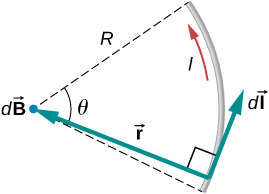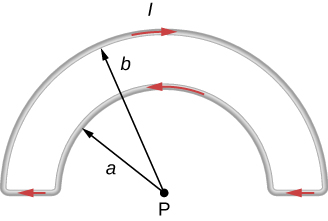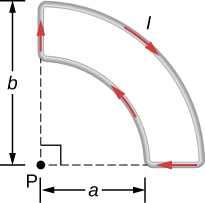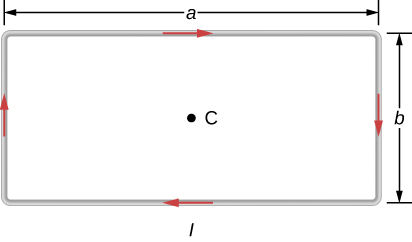| << Chapter < Page | Chapter >> Page > |

The magnetic field at point P is calculated by the Biot-Savart law:
From the right-hand rule and the Biot-Savart law, the field is directed into the page.
Check Your Understanding Using [link] , at what distance would P have to be to measure a magnetic field half of the given answer?
1.41 meters

As we integrate along the arc, all the contributions to the magnetic field are in the same direction (out of the page), so we can work with the magnitude of the field. The cross product turns into multiplication because the path dl and the radial direction are perpendicular. We can also substitute the arc length formula, :
The current and radius can be pulled out of the integral because they are the same regardless of where we are on the path. This leaves only the integral over the angle,
The angle varies on the wire from 0 to ; hence, the result is
Check Your Understanding The wire loop forms a full circle of radius R and current I . What is the magnitude of the magnetic field at the center?
For calculating magnetic fields, what are the advantages and disadvantages of the Biot-Savart law?
Biot-Savart law’s advantage is that it works with any magnetic field produced by a current loop. The disadvantage is that it can take a long time.
Describe the magnetic field due to the current in two wires connected to the two terminals of a source of emf and twisted tightly around each other.
How can you decide if a wire is infinite?
If you were to go to the start of a line segment and calculate the angle to be approximately , the wire can be considered infinite. This judgment is based also on the precision you need in the result.
Identical currents are carried in two circular loops; however, one loop has twice the diameter as the other loop. Compare the magnetic fields created by the loops at the center of each loop.
A 10-A current flows through the wire shown. What is the magnitude of the magnetic field due to a 0.5-mm segment of wire as measured at (a) point A and (b) point B?

Ten amps flow through a square loop where each side is 20 cm in length. At each corner of the loop is a 0.01-cm segment that connects the longer wires as shown. Calculate the magnitude of the magnetic field at the center of the loop.

What is the magnetic field at P due to the current I in the wire shown?

The accompanying figure shows a current loop consisting of two concentric circular arcs and two perpendicular radial lines. Determine the magnetic field at point P.

out of the page
Find the magnetic field at the center C of the rectangular loop of wire shown in the accompanying figure.

Two long wires, one of which has a semicircular bend of radius R , are positioned as shown in the accompanying figure. If both wires carry a current I , how far apart must their parallel sections be so that the net magnetic field at P is zero? Does the current in the straight wire flow up or down?

; the current in the wire to the right must flow up the page.

Notification Switch
Would you like to follow the 'University physics volume 2' conversation and receive update notifications?